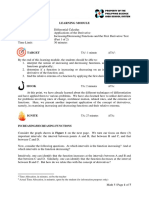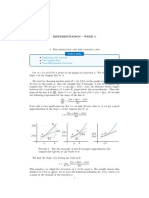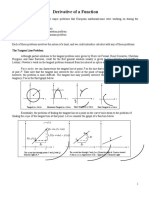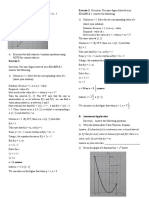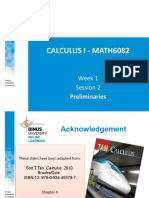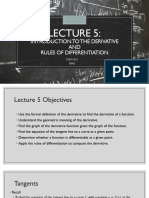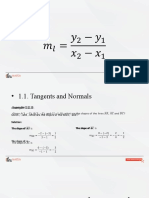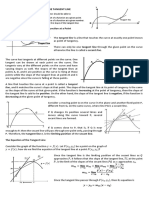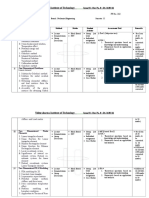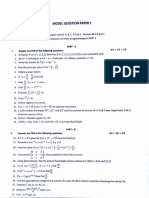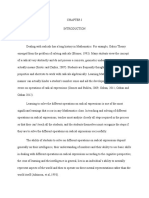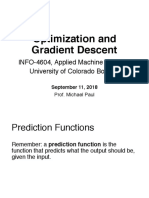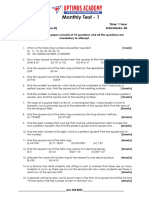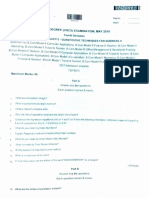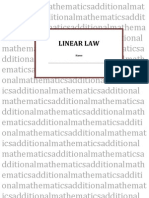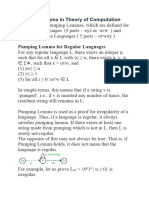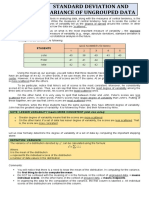16 ESci 113: Calculus for Engineers II
Lesson 3.3: Increasing and Decreasing
Functions
Lesson Summary
From Precalculus lessons, we recall that from the algebraic value of the slope
of a line we already tell whether the line is increasing, decreasing, horizonal,
or vertical. Now in this lesson, we would also be able to do the same with
polynomial curves.
Learning Outcomes
Figure out whether the graph is increasing or decreasing at certain values of
the domain.
Motivation Question
Are their certain points on the graph where the polynomial is neither
increasing nor decreasing?
Discussion
Recalling the Precalculus lesson on linear functions. We determine the trend
of the values of the function as is increasing by the sign of the value of the
slope of the line.
When the slope is negative: the function is decreasing as the value of
increases. Graphically this means that the line is leaning to the left.
The linear function is increasing as increases when the value of the slope
is positive. And the graph of the function should be a line that leans to the
right.
We will apply this knowledge on slope of lines on polynomial curves. We
recall again that slope equals the tangent of the angle between the
horizontal and the line itself. For example, the curve of the polynomial
= −4
is a parabola. And we divide its domain into two intervals,
(−∞, 0) Where the value of is decreasing
(0, ∞) Where the value of is increasing
Page 16 of 172
Vision: A globally competitive university for science, technology, and environmental conservation.
Mission: Development of a highly competitive human resource, cutting-edge scientific knowledge TP-IMD-02
V0 07-15-2020
and innovative technologies for sustainable communities and environment.
No. CET.ESC SLG20-02
� For instructional purposes only • 1st Semester SY 2020-2021 17
If you construct a series of tangent lines on the parabola in the interval of the
domain (−∞, 0), you will notice that the tangent lines have something in
common. All the tangent lines to the parabola at this interval make an obtuse
angle with the -axis. One of these of tangent lines are shown in Figure 1.
The angle in Figure 3.1 is an obtuse angle. This means that the tangent line
is leaning to the left. Hence, the tangent line is decreasing. And as discussed
earlier, if a line is decreasing its slope is negative.
Since all of the tangent lines at the interval (−∞, 0) are decreasing and have
negative slopes, we can safely say that the function in this interval is
decreasing.
Figure 1. A tangent line of parabola representing = − 4 in the interval (−∞, 0)
Figure 2 shows that one of the tangent lines in the interval (0, ∞) is increasing
since the angle that it makes with the -axis is an acute angle. The sign of the
slope of the tangent line must be negative.
Now consider the following points:
The value of the first of derivative of a function at a certain point is the
slope of the tangent line at that same point
The sign of the slope alone can determine whether the line is
increasing or decreasing
In an interval where a polynomial is increasing, the slopes of the
tangent lines may vary; but the slopes of the tangent lines are all
positive
In an interval where the polynomial is decreasing, the signs of the
values derivative must all be negative
Then it is safe to say that to tell whether a polynomial is increasing or
decreasing in an interval, we just need to solve for the value of the derivative
at one point in the interval.
Page 17 of 172
Vision: A globally competitive university for science, technology, and environmental conservation.
Mission: Development of a highly competitive human resource, cutting-edge scientific knowledge TP-IMD-02
V0 07-15-2020
and innovative technologies for sustainable communities and environment.
No. CET.ESC SLG20-02
� 18 ESci 113: Calculus for Engineers II
Figure 2. A tangent line of parabola representing = − 4 in the interval (0, ∞)
What we have discussed so far are the implications of whether the sign of the
first derivative (slope of the tangent line) is positive or negative. Now we will
identify what happens when the value of the first derivative is zero.
The function in Figure 3.2 is decreasing in the interval (−∞, 0). Then it stops
decreasing at = 0 and starts to increase in the interval (0, ∞). The value of
at which the function, = − 4, changes its behavior is zero (0). We also
take note that the tangent line at = 0, in Figure 3.3, is horizontal. Recall that
when the slope is zero, the line should be horizontal. Hence, the value of the
first derivative at = 0 should be zero. To check, we apply the differential
operator on both sides of the equation
( ) = ( − 4)
= 2
Then we evaluate the value of at = 0. By quick substitution we know that
when = 0, = 4.
= 2
( , )
= 2(0)
= 0
( , )
In this case, = 0 is called a critical value or critical number. The point,
(0,4), at which the tangent line is horizontal is the critical point. The function
is said to be stationary at a critical point.
Page 18 of 172
Vision: A globally competitive university for science, technology, and environmental conservation.
Mission: Development of a highly competitive human resource, cutting-edge scientific knowledge TP-IMD-02
V0 07-15-2020
and innovative technologies for sustainable communities and environment.
No. CET.ESC SLG20-02
� For instructional purposes only • 1st Semester SY 2020-2021 19
Figure 3. Horizontal tangent line of parabola representing = −4
We generalize that…
Let = , be any interval where = ( ) is continuous and which does
not obtain any critical value of ( ).
(1) If ( ) > 0 for all < < , then ( ) is increasing in the interval .
(2) If ( ) < 0 for all < < , then ( ) is decreasing in the interval .
And the zeros of the first derivative are the critical points of a function.
Example 3.3
Find the interval where the function defined by ( ) = −6 + 9 + 2 is
(a) increasing and (b) decreasing.
Solution:
The solution will have two parts. We first need to identify the intervals by
solving for the critical values of the function. Then solve for the value of
at a chosen value of in each interval.
= ( )
= −6 +9 +2
Apply differential operator on both sides
( ) = ( −6 + 9 + 2)
= 3 − 12 + 9
Page 19 of 172
Vision: A globally competitive university for science, technology, and environmental conservation.
Mission: Development of a highly competitive human resource, cutting-edge scientific knowledge TP-IMD-02
V0 07-15-2020
and innovative technologies for sustainable communities and environment.
No. CET.ESC SLG20-02
� 20 ESci 113: Calculus for Engineers II
Critical values are the zeros of the first derivative
= 0
0 = 3 − 12 + 9
Factoring
0 = 3( − 4 + 3)
0 = 3( − 3)( − 1)
Equating each factor with zero
0 = 3 Not Acceptable
0 = −3
= 3 Critical value
0 = −1
= 1 Critical value
The intervals, therefore, are:
(−∞, 1) (1,3) (3, ∞)
It is recommended to use the table below as guide:
Sample
Interval from = ( ) Trend
interval, ( , )
(−∞, 1) 0 (0) = 2 =9 Increasing
( , )
(1,3) 2 (2) = 4 = −3 Decreasing
( , )
(3, ∞) 4 (4) = 6 =9 Increasing
( , )
Assessment
Find the interval where your chosen function is increasing and decreasing.
Instructions on how to submit student output
Please see class policies for details.
Page 20 of 172
Vision: A globally competitive university for science, technology, and environmental conservation.
Mission: Development of a highly competitive human resource, cutting-edge scientific knowledge TP-IMD-02
V0 07-15-2020
and innovative technologies for sustainable communities and environment.
No. CET.ESC SLG20-02
